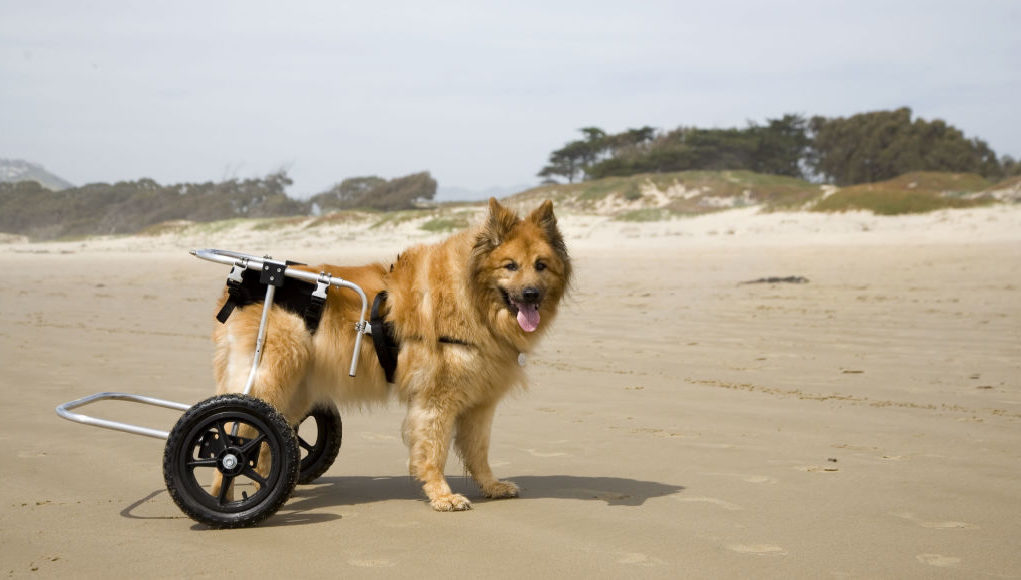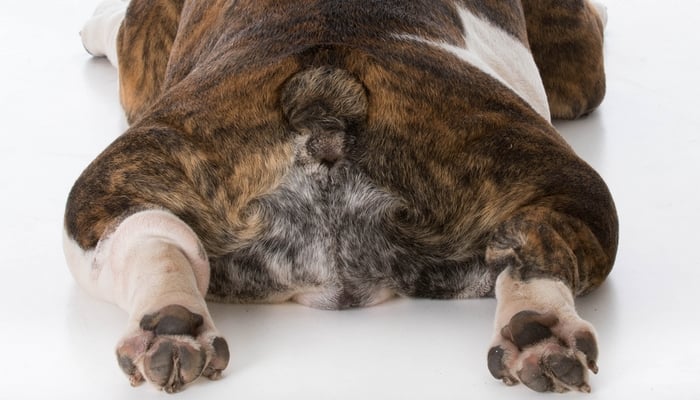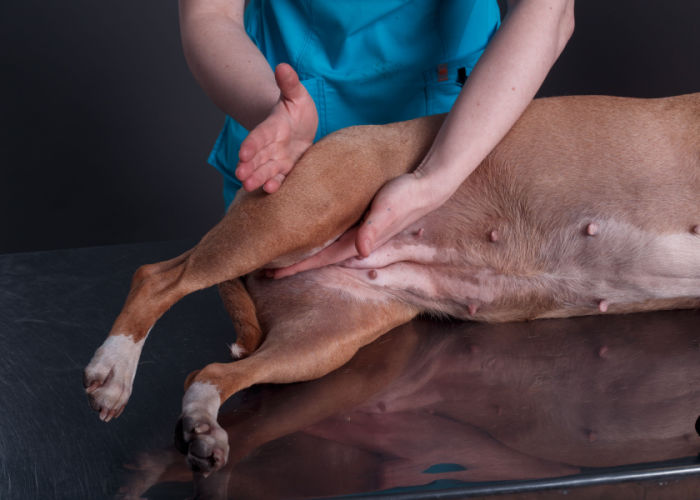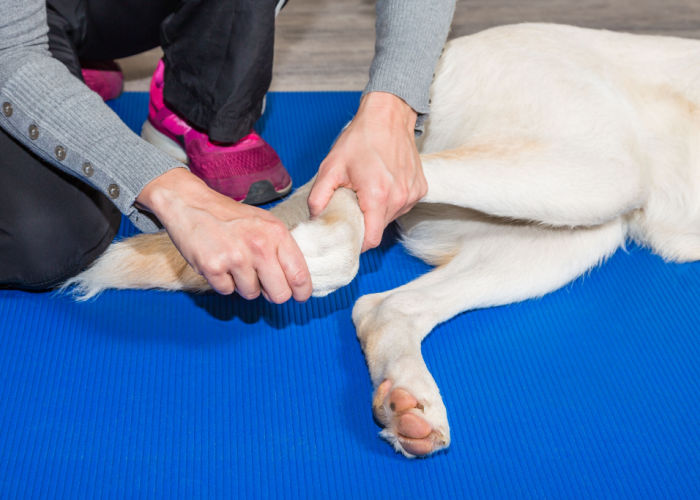Table of Contents
Hip dysplasia in dogs is one of the most common canine hip problems that can be common for dogs of all ages and sizes – especially if it runs in their genes.
There are several ways how to spot hip dysplasia in dogs at its early stage.
Below, let's discuss what is canine hip dysplasia, its signs and symptoms, causes, treatment, and how to prevent it from happening to your dogs.
Hip Dysplasia in Dogs: What is it?
Canine hip dysplasia happens when the ball and joint of the hips don't form or develop properly, resulting in deterioration and dysfunction.
As the pup grows older (and heavier,) its hip joints bear extra pressure. The body tries to compensate for the weak hips that's why later on, Degenerative Joint Disease and Osteoarthritis may develop.
This can be quite painful for the dogs, resulting in their limited movement.
Larger breeds vs Smaller breeds
Hip dysplasia is more common for larger breeds such as German Shepherds, Labrador Retrievers, Golden Retrievers, Saint Bernards, Old English Sheepdogs, and Bulldogs.
Even mixed-breeds that are on the larger side are also prone to having hip dysplasia.
However, smaller to mid-size breeds are also susceptible to developing this disease. Pugs, French Bulldogs, Shih Tzus, Affenpinscher, and Poodle are some of the smaller breed dogs that are prone to developing hip dysplasia.
Older dogs vs Puppies
Although hip dysplasia usually starts at birth, a puppy may not show clinical signs during the first 18 months. Instead, signs and symptoms may be noticeable only by the time they are adults.
Hip Dysplasia affects both young and old dogs but not always in the same way.
Hip Dysplasia in Dogs: Causes
The main cause of hip dysplasia in dogs is hereditary in nature. Dogs can pass this on to their offspring, which if not prevented, could lead to serious conditions.
While genetics play a big role in getting this disease, it can still be affected by many factors such as the diet of the pup, environment, exercise, growth rate, muscle mass, and hormones.
Hip Dysplasia in Dogs: Signs and Symptoms
You may wonder how to easily spot hip dysplasia as early as possible.
Because some puppies don't display obvious clinical signs in the beginning, having them checked for hip dysplasia could help in early detection (especially if they are prone to getting one!)
Nevertheless, here are the common signs you may see on a puppy or older dog that possibly has hip dysplasia.
- Lameness or limping in one or both hind legs
- Swaying, “bunny hopping”
- Decrease in thigh muscles
- Grating in the joint when moving
- Difficulty in rising, jumping, running, or climbing
- Abnormal sitting position
- General decrease in activity and range of motion
- Enlargement of shoulder muscles to compensate for weak hind
- Crying because of painful hip joints
- Always shifts weight to front legs
- Difficulty in physical exercise for long periods of time
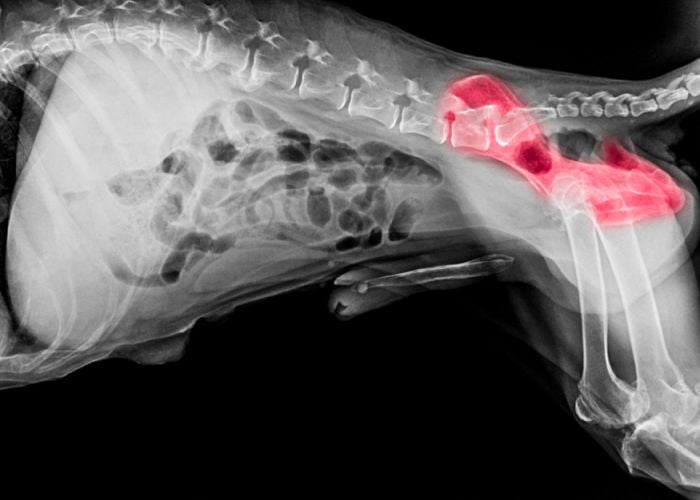 Hip Dysplasia in Dogs: Treatment
Hip Dysplasia in Dogs: Treatment
Luckily, there are measures that can be done to correct hip dysplasia as soon as it was diagnosed. And as all illnesses or diseases go, it's always easier to treat them if detected earlier.
But before it can be treated, a correct diagnosis is needed.
Diagnosis
As soon as you suspect that your dog might be suffering from hip dysplasia (check the symptoms above!) talk to your vet about it. He or she will perform a physical check-up on your dog.
If your vet agrees with your suspicion, diagnostic tests may be done like a radiograph or X-ray. Blood work may also be ordered to check if there are other complications like inflammation.
You would also have to tell the vet the medical history of your dog—has there been an accident in the past? Any other diagnosis that might be related or not related to its hip discomfort? How about its diet? Exercise routine?
All this information is needed to plan the most appropriate treatment course for your dog's hip dysplasia.
Prognosis
Good news! Hip Dysplasia doesn't affect a dog's life expectancy at all.
Dogs that are diagnosed with this can have a long, healthy life as long as there are treatments being done to address this.
However, if left untreated, canine hip dysplasia may significantly affect their quality of life (especially for dogs who enjoy an active lifestyle!).
Their limited movement caused by the pain in their hip joints will definitely restrict them and won't allow them to be as active as they want.
Treatment of Hip Dysplasia
There are several treatments for hip dysplasia in dogs. This, however, depends on your dog's clinical signs and the amount of discomfort it feels.
Corrective Surgery
Also depending on your dog's age is the corrective surgery that your vet may perform.
Puppies that are not older than 10 months can have procedures called Juvenile Pubic Symphysiodesis or Triple Pelvic Osteotomy.
Adult dogs with a matured bone structure and possibly increased joint pain can undergo Femoral Head Osteotomies or Total Hip Replacements.
The cost depends on the actual surgical treatment to be performed, your location, and the type of facility it's going to be performed.
But don't worry, not all hip dysplasia in dogs make them candidates for surgery. Some can still be corrected with proper therapy.
Physical Therapy
Physical therapy can be done as a complementary treatment to other medications or operations to correct hip dysplasia in dogs.
Because it encourages hip joint mobility and muscle health, Physical therapy can decrease pain and other symptoms caused by hip dysplasia in your dog.
However, this when done alone cannot correct hip dysplasia. Experts still recommend physical therapy to be performed along with other treatments such as hip injections.
Medical Management
Your vet will most likely prescribe medications and supplements to ease your dog's pain and symptoms because of hip dysplasia.
Oral joint supplements may be given with ingredients like omega fatty acids and glucosamine.
There is also an option for injectable therapies that can also help with joint health.
To help with inflammation and as a pain relief, Non-Steroidal Anti-Inflammatory drugs or NSAIDs that has minimal side effects may also be prescribed by the vet, as well as Joint Fluid Modifiers.
Lifestyle Modification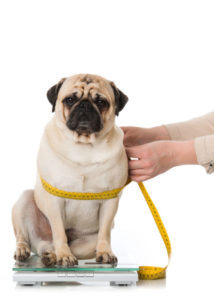
Weight reduction (especially for large breeds) will also do wonders to your dog's overall hip joint health as it will take off pressure from their hip joints.
A healthy diet is also recommended to make sure that your dog is getting all the necessary nutrients it needs especially suited to its condition.
Your vet may also set simple exercise routines for your dog like walking or swimming.
Avoid jumping or running for long periods of time especially on hard surfaces as it gives extra pressure on your dog's joints.
Just remember to let your dog set the pace when doing these simple physical activities.
Hip dysplasia or not, we have to maintain our dogs at their ideal weight to prevent any disease from popping up.
Alternative Medicine Treatments
Alternatively, experts are now exploring several medical treatments to help manage canine hip dysplasia.
Examples are acupuncture, stem cell treatment, and even traditional Chinese medicine. However, these have varying results and still need more scientific studies to establish their actual contribution to treating hip dysplasia in dogs.
You may ask your veterinarian regarding his personal knowledge or experience with these alternative treatments.
Hip Dysplasia in Dogs: How can I help my dog?
Being proactive in diagnosing and treating hip dysplasia in your dog is good enough to really help your dog make the most out of its life.
Be sure to watch out for what your dog eats and always keep its weight in check.
But apart from that, there are several home remedies you can do to help relieve your dog's pain because of hip dysplasia.
Home Relief for Hip Dysplasia
- Gently massage your dog's hips by rubbing them in a circular motion.
- Make sure to do it as gently as you can to avoid worsening the pain. If your dog seems to not like it, don't force it.
- Apply a warm compress to your dog's hips at least twice a day.
- Make sure that your dog stays warm, especially during the colder season. Trust me, the chilly weather is easily the number one nemesis of an aching joint!
- Buy a firm, orthopedic bed for your dog to relax in.
- Add carpets, rubber, or any form of traction on slippery floors. This will help your dog with hip dysplasia move around freely, with no risks of possible further accidents from happening.
Hip Dysplasia in Dogs: Prevention
Although hip dysplasia is more of a genetic disease that develops over time, there are still ways for you to keep your dogs in tip-top shape.
Number one, of course, is to feed them a proper diet. Letting the dogs eat whatever and how much they want is more prone to developing any bone or joint diseases (not just hip dysplasia!)
Keeping them in their ideal weight is always, always recommended!
Of course, always ensure proper exercise (especially the couch potatoes!)
Daily walking for at least 20 to 30 minutes should be enough to make sure they are getting adequate physical activity for the day.
Also, don't ignore the benefits of health supplements! There are many oral supplements that can be given to pets depending on what they most need.
For dogs that are prone to hip dysplasia, giving them a quality joint supplement will help a lot in preventing this condition to worsen.
Of course, always have them consult with the vet to know what more can you do to help your dog live a long and healthy life!
Frequently Asked Questions About Dog Hip Dysplasia
What are the first signs of Hip Dysplasia in Dogs?
Limping and lameness especially on their backside could be the first indicator that your dog has hip dysplasia.
Other symptoms you may notice are stiffness in their hind muscle, cracking or popping sound in their hip joint when walking, difficulty in standing on legs, climbing legs, or jumping, weird sitting position, and a general decrease in physical activities like running.
Can Hip Dysplasia in Dogs be fixed?
With the proper treatment and medical management, yes, hip dysplasia in dogs can be fixed.
Depending on your dog's clinical signs and overall discomfort, the vet surgeon may recommend surgery, anti-inflammatory medications, and joint supplements, along with complementary treatment like physical therapy.
Giving them proper diet and exercise will also help in their weight management, which is very important in managing hip dysplasia.
At what age does Hip Dysplasia appear in dogs?
There are cases when puppies that are younger than 18 weeks already show signs of hip dysplasia early on.
However, there are also cases where the owners only notice any outward symptoms of hip dysplasia when the dog has already matured.
If your dog is a large breed and has a known history of hip dysplasia from a parent, have it checked early on to prevent any complications from developing further.
What happens if Canine Hip Dysplasia is left untreated?
If left untreated, Canine Hip Dysplasia can progress to osteoarthritis and further degeneration of the hip joints.
While this may not affect their life expectancy, hip dysplasia in dogs can definitely be painful which will have an impact on their quality of life.
You as the owner may also feel their discomfort and burden as they will definitely need more of your assistance even for common tasks because of their limited movements.
Hip Dysplasia in Dogs – Summary
Hip dysplasia in dogs is not an uncommon hip problem, especially for larger breeds. But getting diagnosed with it doesn't mean the end of the world for you and your pup!
There are easy ways to prevent it from developing over time and a lot more treatment options for canine hip dysplasia.
What's important is being able to spot the signs and symptoms early on, and giving your dog a hand with home remedies and pain relief for this condition.
With proper treatment and care management, you and your dog can surely go back to the things you both love doing together.


